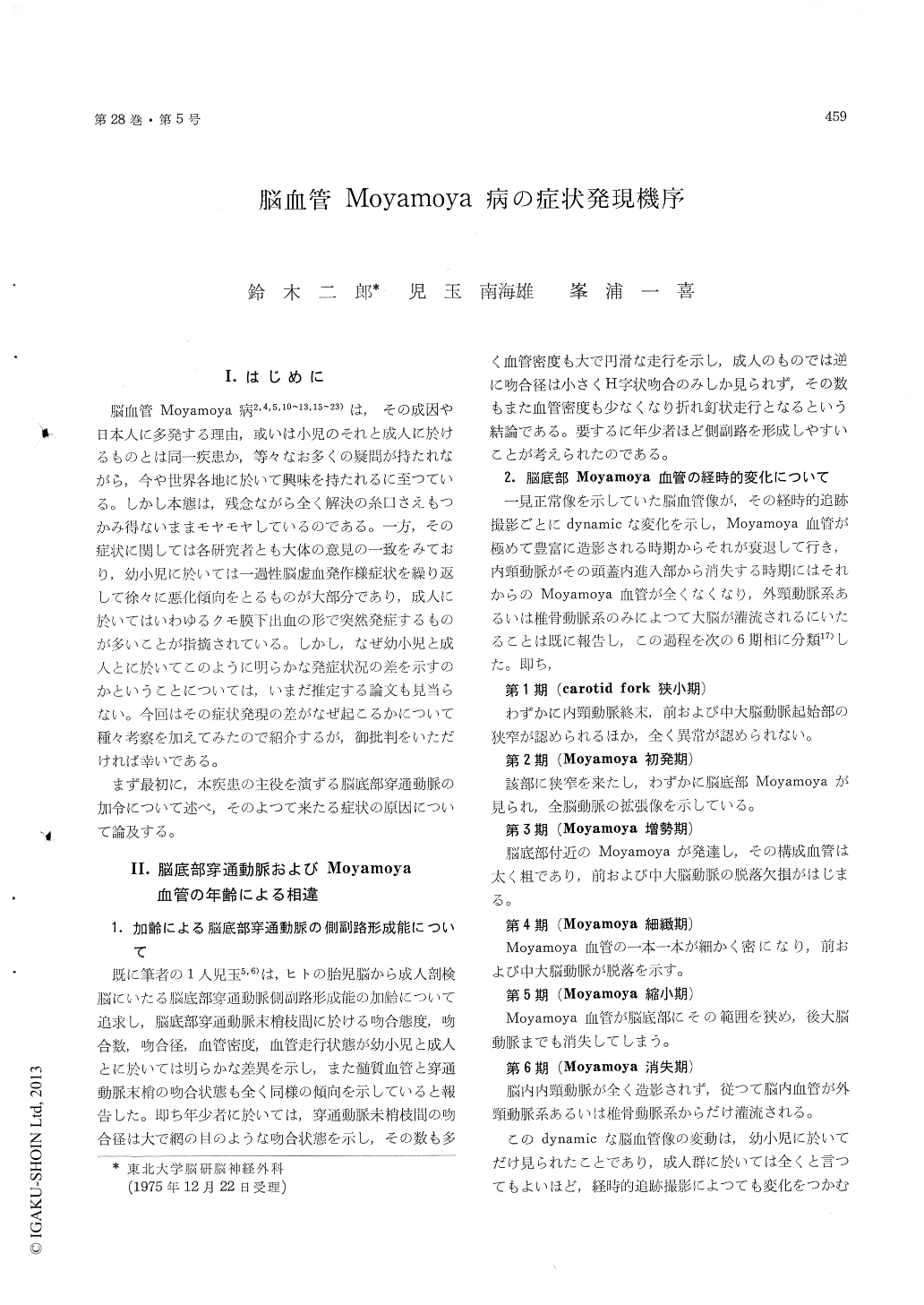Japanese
English
- 有料閲覧
- Abstract 文献概要
- 1ページ目 Look Inside
I.はじめに
脳血管Moyamoya病2,4,5,10〜13,15〜23)は,その成因や日本人に多発する理由,或いは小児のそれと成人に於けるものとは同一疾患か,等々なお多くの疑問が持たれながら,今や世界各地に於いて興味を持たれるに至つている。しかし本態は,残念ながら全く解決の糸口さえもつかみ得ないままモヤモヤしているのである。一方,その症状に関しては各研究者とも大体の意見の一致をみており,幼小児に於いては一過性脳虚血発作様症状を繰り返して徐々に悪化傾向をとるものが大部分であり,成人に於いてはいわゆるクモ膜下出血の形で突然発症するものが多いことが指摘されている。しかし,なぜ幼小児と成人とに於いてこのように明らかな発症状況の差を示すのかということについては,いまだ推定する論文も見当らない。今回はその症状発現の差がなぜ起こるかについて種々考察を加えてみたので紹介するが,御批判をいただければ幸いである。
まず最初に,本疾患の主役を演ずる脳底部穿通動脈の加令について述べ,そのよつて来たる症状の原因について論及する。
Main symptom of cerebrovascular Moyamoya dis-ease in children is T. I. A.-like stroke and that inadults is the symptom of subarachnoid hemorrhage.This is the report on the mechanism of symptomaticoccurrence in this disease based on our follow upstudy of carotid angiograms.
(1) The mechanism of T. I. A.-like stroke inyoung patients is not caused by embolism of theatheroma plaque from the carotid artery at theneck portion, as T. I. A. has been supposed to be.But it occurs when the perforating arteries areobstructed one after another, which is caused byslow progressive narrowing and/or occlusion, ofmain cerebral arteries, beginning from the carotidfork. However, it disappears immediately after thecollateral pathway between the perforating branchesand other vessels are formed. After all the per-forating arteries are obstructed with repetition ofthis mechanism, T. I. A.-like stroke would not occurany more.
(2) It has generally been thought that the initialsymptom of adult patients is subarachnoid hemor-rhage, due to rupture of vessels in the subarachnoidspace on the brain surface. However, we have ex-perienced three cases, in which aneurysmal shadowslocated close to the upper lateral edge of the lateralventricle were revealed on the carotid angiogram.According to the follow up study of the carotidangiogram, these aneurysmal shadows which haddisappeared comletely were considered to be thepseudo-aneurysms, which indicated the bleedingpoint.
The facts mentioned above may suggest thefollowing mechanism. First, small artery rupturesnear the lateral ventricle. Then blood penetratesinto it. But the small blood clot or in other words,pseudo-aneurysm remains. The blood which haspenetrated into the lateral ventricle, circulates intothe subarachnoid space, therefore the symptom andsign are misunderstood as those of subarachnoidhemorrhage. Later, the blood clot vanishes bycomplete absorption. In addition to that, why thisregion is a weak point for bleeding is discussed.
(3) An experience of cerebrovascular Moyamoyadisease associated with basilar aneurysm is also re-ported. According to the follow-up study of thecarotid angiogram and/or craniotomy, it is suggestedthat these aneurysms should not be pseudo-an-eurysms but saccular aneurysms, and that thereshould be another mechanism of symptomatic oc-currence in adult patients; to begin with ruptureof basilar aneurysms.

Copyright © 1976, Igaku-Shoin Ltd. All rights reserved.


